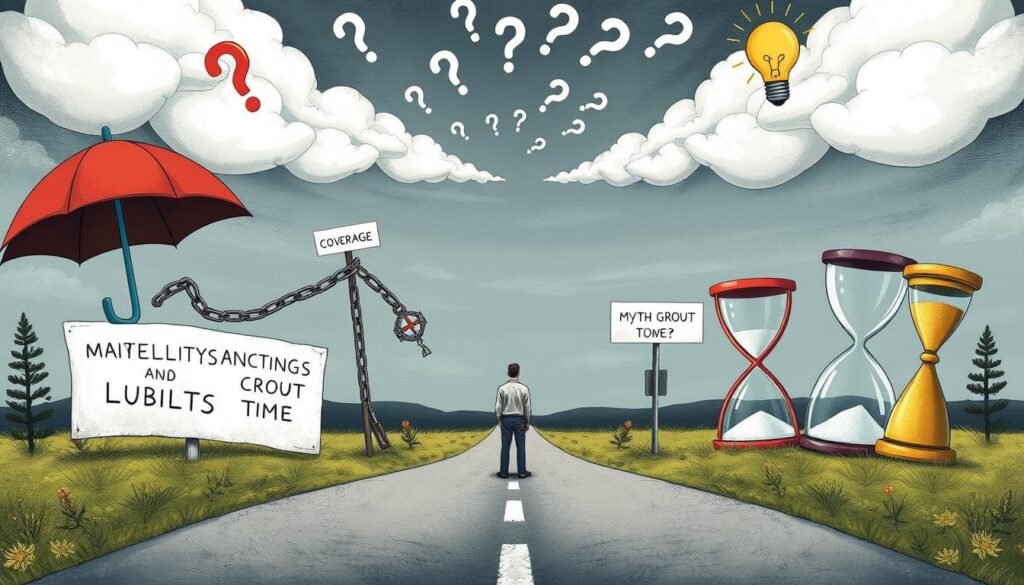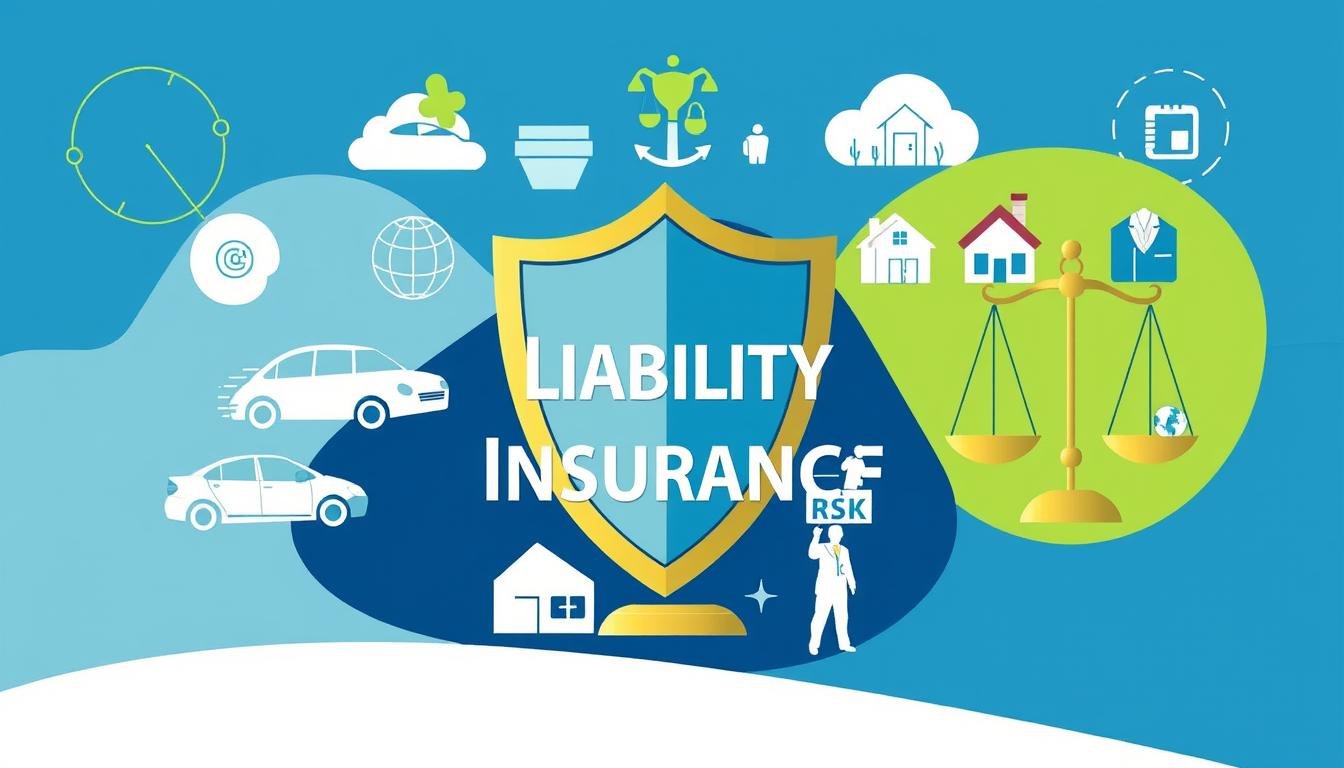Did you know that nearly 20% of all lawsuits filed in the United States involve claims primarily related to liability insurance? This staggering statistic underscores the critical role of understanding liability in insurance for both individuals and businesses. Liability insurance coverage acts as a vital safety net, safeguarding policyholders from potentially devastating financial losses due to legal claims by third parties. It is imperative for policyholders to grasp their rights and responsibilities regarding insurance liability protection. They must also navigate the complexities that can arise from policyholder rights and liabilities.
In this exploration, we will delve into the various aspects of liability insurance. We aim to provide clarity on how it operates, its indispensable nature, and how to ensure adequate coverage.
Key Takeaways
- Liability insurance protects against financial damage from third-party claims.
- Understanding your policy helps navigate complex claims processes.
- Different types of liability coverage exist for businesses and individuals.
- Regularly reviewing your policies ensures adequate protection.
- Awareness of exclusions can prevent costly surprises during a claim.
- Comparing policies is essential for selecting the right coverage.
What is Liability Insurance?
Liability insurance is a vital component of any comprehensive insurance plan. It acts as a safety net, shielding individuals and businesses from potential financial losses due to legal claims. Grasping the various insurance liability definitions is crucial for selecting the appropriate coverage for your specific needs.
Definition and Purpose
The primary aim of liability insurance is to offer financial protection against legal liabilities for damages or injuries to others. This coverage is indispensable for risk management, whether in personal or business contexts. With the right liability insurance coverage, policyholders can defend against claims and bear the costs of legal proceedings.
Common Types of Liability Insurance
There are several types of insurance liabilities designed for different scenarios, including:
- General Liability Insurance: This type covers claims involving bodily injury, property damage, and personal injury. It is crucial for businesses to safeguard against claims stemming from their daily operations.
- Professional Liability Insurance: Commonly known as errors and omissions (E&O) insurance, this coverage shields professionals against claims of negligence or subpar work. It is particularly vital for individuals in fields like law, medicine, and finance.
- Product Liability Insurance: This insurance offers coverage for businesses against claims related to damages caused by products they manufacture or sell. It protects companies from lawsuits concerning defective products.
Why Liability Insurance is Essential
Liability insurance is pivotal for safeguarding both individuals and businesses. It acts as a protective barrier against unforeseen events, ensuring that policyholders can manage legal costs and settlements from liability claims. The importance of liability insurance is profound, highlighting the need for financial security in an uncertain world.
Financial Protection
The core purpose of liability insurance is to safeguard against financial claims. Legal expenses can surge rapidly, threatening financial stability. Adequate coverage allows individuals and businesses to face challenges without financial strain. This assurance provides peace of mind, knowing that significant liabilities can be effectively managed.
Legal Requirements
In various sectors, legal mandates necessitate specific liability insurance types. Adherence to these legal mandates prevents legal repercussions and fosters a safer environment for all. Industries like construction, healthcare, and transportation have strict regulations requiring sufficient liability coverage. Recognizing these mandates underscores the critical role of liability insurance in professional settings.
Types of Liability Insurance Policies
Grasping the nuances of liability insurance policies is crucial for securing comprehensive coverage. These policies cater to diverse needs, each with its specific purpose.
General Liability Insurance
General liability insurance shields businesses against third-party claims for bodily injury or property damage. It is indispensable for any enterprise, mitigating risks associated with unforeseen accidents. This coverage is pivotal in safeguarding a company’s interests and ensuring operational continuity.
Professional Liability Insurance
Professional liability insurance, commonly referred to as errors and omissions insurance, safeguards professionals against claims stemming from negligence or service-related errors. It is paramount for professionals in high-risk sectors like medicine, law, and consulting. Acquiring this insurance is a prudent step to safeguard one’s professional standing and financial well-being.
Product Liability Insurance
Product liability insurance is imperative for manufacturers and retailers, addressing claims linked to defective products causing injury or harm. It not only safeguards the company’s financial health but also instills confidence in consumers regarding product safety. For entities involved in product distribution, this coverage is essential for effective risk management.
Exploring various insurance options empowers businesses to select the most suitable coverage. A thorough understanding of each policy facilitates more effective risk mitigation and loss prevention strategies.
Key Terms to Know in Liability Insurance
Comprehending fundamental terminology within liability insurance is indispensable for any policyholder. It simplifies the complexities of the policy, facilitating a better understanding of your financial obligations. The concepts of premiums, deductibles, and coverage limits are pivotal in insurance calculations and decision-making processes.
Premiums
Premiums denote the financial outlay for liability insurance. This cost fluctuates based on several variables, including coverage type, chosen limits, and risk profile. Regularly evaluating your premium is crucial. It influences your budget and financial obligations, ensuring sufficient protection without unnecessary expenditure.
Deductibles
A deductible is the initial amount you must cover before your insurance intervenes. Elevating your deductible can lower premiums but escalates your financial burden during claims. Grasping deductibles empowers policyholders to strategize their insurance approach and manage potential liabilities adeptly.
Coverage Limits
Coverage limits signify the utmost insurance payout for claims. These limits are highly variable, contingent on policy type and chosen coverage. Acquaintance with coverage limits is essential for adequate protection. It safeguards against unforeseen financial burdens during claims, embodying a critical component of liability insurance comprehension.
How Liability Insurance Works
Grasping the mechanics of liability insurance is paramount for those in search of protection. The journey commences with the submission of a claim following an incident. This entails a series of steps in the liability claims process, which significantly influences the outcome of your insurance experience. Upon claim submission, the insurer scrutinizes the details, collecting essential evidence to substantiate the claim.
The Claims Process
Effective dialogue with your insurance representative is pivotal in streamlining the liability claims process. Essential actions include:
- Inform your insurer immediately upon the occurrence of the incident.
- Supply all pertinent information, encompassing photographs, witness statements, and police reports.
- Regularly follow up to ascertain the claim’s status.
Adherence to these measures can expedite claim resolution, facilitating comprehension of the legal proceedings that may ensue. Insurance agents often provide insight into the documentation required.
What Happens in a Lawsuit
Should a lawsuit arise, comprehending how liability insurance safeguards you is imperative. Policies generally cover legal defense expenditures and settlements up to the stipulated limits. This support is invaluable in navigating the complexities of legal proceedings, which can be daunting without professional guidance.
Insurance coverage aids in mitigating the uncertainties of potential litigation, enabling policyholders to concentrate on resolving the issue rather than being entangled in legal complexities.
Common Misconceptions About Liability Insurance

Grasping the nuances of liability insurance is paramount for safeguarding one’s financial well-being. Misconceptions frequently cloud the understanding of policyholders. This segment aims to debunk prevalent myths, shedding light on the scope of coverage and the existence of exclusions within policies.
Misunderstanding Coverage Limits
Many individuals harbor the misconception that their liability policy encompasses all eventualities. This belief is fundamentally flawed. Coverage limits delineate the utmost amount an insurer is obligated to compensate in claims. Should claims surpass these limits, policyholders may find themselves liable for the excess costs. It is imperative to scrutinize one’s policy meticulously to grasp the precise limits pertinent to different incidents.
Beliefs About Exclusions
Understanding exclusions is crucial for grasping what is not covered under a liability policy. A prevalent misconception posits that all damages or claims will be indemnified. Conversely, most policies enumerate specific exclusions, encompassing intentional acts or certain business undertakings. Clarifying the extent of coverage necessitates acknowledging these exclusions, thereby averting unrealistic expectations.
How to Choose the Right Liability Insurance
Opting for liability insurance necessitates a meticulous evaluation to guarantee that the chosen policy aligns with specific requirements. It is imperative to assess personal or business risks, as this step is fundamental in determining the requisite coverage level for safeguarding interests. Familiarizing oneself with the distinct attributes of various policies facilitates an informed decision-making process.
Assessing Your Needs
Initiate by pinpointing the unique risks inherent to your circumstances. Variables such as industry, business scale, and personal lifestyle significantly influence insurance necessities. When evaluating your needs, consider the following:
- Nature of your business or personal activities
- Potential liabilities you might face
- Legal mandates in your state
By scrutinizing these elements, a more precise understanding of the necessary coverage can be attained. This understanding enables the exploration of personalized insurance solutions specifically tailored to your scenario.
Comparing Policy Features
Implementing effective policy comparison strategies is vital for selecting the optimal insurance. Concentrate on aspects beyond premiums, such as:
- Coverage limits offered by each policy
- Specific exclusions and inclusions that apply
- Claims handling reputation of the insurance provider
Employing resources for policy comparison not only simplifies the process but also aids in identifying the most suitable option. A detailed analysis of policy specifics ensures a well-informed selection, ensuring adequate protection against potential liabilities.
Reviewing Your Liability Insurance Policy
Engaging in a regular liability insurance review is paramount for ensuring comprehensive coverage. Many policyholders fail to grasp the intricacies of their policies, leading to potential misunderstandings or insufficient protection. It is imperative to delve into the policy details, thereby enhancing your understanding. Let us delve into the process and pinpoint the key aspects to focus on during your review.
Understanding Policy Language
The lexicon employed in insurance documents frequently presents a challenge. Mastery over common terms is essential for grasping your policy’s content. By concentrating on definitions, you can demystify terms that initially appear complex. Here are some considerations:
- Seek clarification from your insurance agent when necessary.
- Document unfamiliar terms and seek their definitions online.
- Examine your policy’s declarations page for a comprehensive coverage overview.
Checking for Inclusions and Exclusions
Identifying the inclusions and exclusions within your policy is crucial for effective coverage. It is important to focus on the following:
- Inclusions: Understand the events or circumstances your policy covers.
- Exclusions: Familiarize yourself with what is specifically excluded, as this can affect your claim filing capabilities.
- Explore any endorsements or additional coverage options that might be relevant.
Liability Coverage for Business Owners

Business owners must acknowledge the crucial role of liability insurance in safeguarding their assets and ensuring uninterrupted operations. This coverage provides financial protection against claims stemming from injuries, damages, or other liabilities, thereby safeguarding both personal and business assets. The incorporation of effective enterprise risk management practices is essential for business success, with liability insurance serving as a fundamental component of these strategies.
Importance of Liability Insurance in Business
The essence of business liability insurance lies in its capacity to shield enterprises from unforeseen events. Without sufficient coverage, a single claim could imperil overall stability, potentially leading to financial collapse. The key benefits include:
- Protection against third-party claims for damages or injuries.
- Reassurance for clients and customers that they are engaging with a responsible business.
- Support for maintaining operational continuity during legal disputes.
Different Policies for Various Industries
Industry-specific policies are designed to address the unique risks each business may encounter. These customized approaches ensure that enterprise risk management is in sync with operational requirements. Common industry-specific policies include:
- Construction Liability Insurance: Addresses risks related to construction projects, covering potential accidents on-site.
- Healthcare Liability Insurance: Protects medical professionals from claims resulting from negligent acts or omissions related to patient care.
- Technology Errors and Omissions Insurance: Focuses on risks faced by tech companies, safeguarding against issues arising from software failures or data breaches.
Personal Liability Insurance and Homeowners Policies
Homeowners insurance frequently encompasses a crucial element known as personal liability coverage. This safeguard is indispensable for homeowners, offering financial backing in scenarios where someone is injured on their premises or if they inadvertently damage another’s property. Grasping the nuances of homeowners insurance coverage empowers you to make informed decisions regarding your financial well-being.
Coverage Within Homeowners Insurance
Standard homeowners insurance policies extend personal liability protection, shielding against a myriad of liability claims. Coverage levels vary by policy but generally encompass:
- Injury to guests on your property
- Damage caused by pets
- Legal expenses stemming from liability claims
This coverage is pivotal in mitigating risks associated with accidents, solidifying its role in a homeowner’s comprehensive financial protection strategy.
Additional Personal Liability Options
For those desiring a more robust safety net, additional insurance options are available. These might include:
- Umbrella insurance policies offering supplementary coverage beyond standard homeowners insurance
- Personal liability riders custom-crafted to meet individual needs and circumstances
Investigating these alternatives enables homeowners to bolster their personal liability protection, ensuring they are adequately prepared for unforeseen occurrences.
The Role of Liability Insurance in Risk Management
Liability insurance is a fundamental element in risk management strategies. It enables individuals and businesses to mitigate potential risks through tailored approaches. This not only fortifies protection but also bolsters the financial resilience of the policyholder.
Evaluating Risks
Initiating a risk management strategy begins with a thorough risk assessment. Key considerations include:
- Nature of business activities or personal responsibilities
- Potential hazards associated with products or services
- Frequency and severity of possible claims
This process aids in pinpointing vulnerabilities, guiding decisions on necessary coverage. It ensures the implementation of robust risk management strategies.
Reducing Liability Exposure
Minimizing liability exposure transcends mere insurance acquisition. Several proactive measures can be taken:
- Implement safety protocols and conduct regular training
- Utilize disclaimers and contracts to clarify responsibilities
- Review and update insurance policies regularly based on changing needs
Adopting these measures enhances safety and ensures liability coverage remains efficacious. A comprehensive insurance plan, coupled with continuous risk evaluations, significantly reduces liability exposure.
Conclusion: Ensuring Adequate Liability Coverage
In the dynamic realm of insurance, it is imperative for policyholders to ensure their liability insurance accurately mirrors their needs and circumstances. The necessity of staying abreast of coverage updates cannot be overstated, given the fluid nature of legal standards and personal situations. A thorough comprehension of one’s policy is pivotal in navigating the complexities of uncertainty.
Staying Informed of Policy Changes
Engaging in regular policy reviews is a fundamental step towards maintaining the efficacy and relevance of your liability insurance. This process encompasses not only the evaluation of coverage limits but also a deep dive into any policy term alterations. Proactive engagement with policy modifications empowers you to adapt to emerging risks, thereby averting potential coverage gaps.
The Importance of Regular Reviews
The significance of policy reviews cannot be overstated; they empower you with the knowledge necessary for making informed decisions regarding your coverage. Through periodic evaluations, you can fortify your protection against unforeseen occurrences. An informed stance towards your insurance is instrumental in ensuring your peace of mind, allowing you to confront risks with unwavering confidence.
FAQ
What is liability insurance?
Liability insurance acts as a financial safeguard, shielding policyholders from the financial repercussions of damages or injuries inflicted upon a third party. It encompasses legal fees, settlements, and any ancillary costs stemming from liability claims.
Why do I need liability insurance?
Liability insurance is indispensable for both individuals and corporations, serving as a bulwark against financial devastation occasioned by legal actions and claims. It guarantees the capacity to absorb unforeseen legal expenditures and fulfills regulatory mandates within your sector.
What types of liability insurance are available?
Liability insurance manifests in various forms, including general liability, professional liability, and product liability. Each variant is tailored to address distinct risks, safeguarding against the vicissitudes of diverse activities and vocations.
What are the coverage limits in a liability insurance policy?
Coverage limits delineate the utmost liability the insurer will undertake for a claim. It is imperative for policyholders to grasp these limits, thereby ascertaining the extent of their liability protection.
How does the liability claims process work?
The liability claims process commences with the notification of your insurer regarding a claim, followed by the submission of requisite documentation. An adjuster will then evaluate the claim, determining the extent of coverage, contingent upon your policy’s stipulations.
What are my rights as a policyholder?
Policyholders are endowed with rights to comprehend their policy’s coverage, receive equitable treatment from their insurer, and initiate claims in accordance with their policy’s terms. Should you perceive a transgression of these rights, it is imperative to seek counsel on your entitlements and liabilities.
Are there common misconceptions about liability insurance?
Indeed, numerous myths prevail regarding liability insurance, particularly concerning coverage limits and exclusions. It is crucial for policyholders to dispel these misconceptions, thereby ensuring a comprehensive understanding of their coverage and averting unforeseen consequences during a claim.

